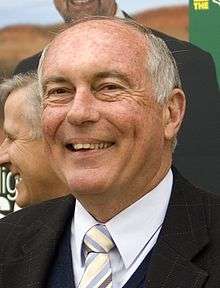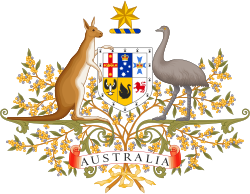Warren Truss
Warren Errol Truss, AC (born 8 October 1948) is a former Australian politician who served as the 16th Deputy Prime Minister of Australia and Minister for Infrastructure and Regional Development in the Abbott Government and the Turnbull Government.[1] Truss served as the federal leader of the National Party of Australia (The Nationals) between 2007 and 11 February 2016 when he announced his decision to retire and not contest the 2016 federal election.[2][3][4] He was the member of the House of Representatives for Wide Bay from the 1990 election until his retirement in May 2016. Following the merger of the Queensland branches of the Nationals and Liberals, Truss was re-elected in 2010 for the Liberal National Party.
Warren Truss AC | |
|---|---|
 | |
| Deputy Prime Minister of Australia | |
| In office 18 September 2013 – 18 February 2016 | |
| Prime Minister | Tony Abbott Malcolm Turnbull |
| Preceded by | Anthony Albanese |
| Succeeded by | Barnaby Joyce |
| Minister for Infrastructure and Regional Development | |
| In office 18 September 2013 – 18 February 2016 | |
| Prime Minister | Tony Abbott Malcolm Turnbull |
| Preceded by | Anthony Albanese (Infrastructure and Transport) Sharon Bird (Regional Development) |
| Succeeded by | Darren Chester (Infrastructure and Transport) Fiona Nash (Regional Development) |
| Leader of the National Party Elections: 2010, 2013 | |
| In office 3 December 2007 – 11 February 2016 | |
| Deputy | Nigel Scullion Barnaby Joyce |
| Preceded by | Mark Vaile |
| Succeeded by | Barnaby Joyce |
| Minister for Trade | |
| In office 10 August 2006 – 3 December 2007 | |
| Prime Minister | John Howard |
| Preceded by | Mark Vaile |
| Succeeded by | Simon Crean |
| Minister for Transport and Regional Services | |
| In office 6 July 2005 – 10 August 2006 | |
| Prime Minister | John Howard |
| Preceded by | John Anderson |
| Succeeded by | Mark Vaile |
| Minister for Agriculture, Fisheries and Forestry | |
| In office 20 July 1999 – 6 July 2005 | |
| Prime Minister | John Howard |
| Preceded by | Mark Vaile |
| Succeeded by | Peter McGauran |
| Member of the Australian Parliament for Wide Bay | |
| In office 24 March 1990 – 2 July 2016 | |
| Preceded by | Clarrie Millar |
| Succeeded by | Llew O'Brien |
| Personal details | |
| Born | Warren Errol Truss 8 October 1948 Kingaroy, Queensland, Australia |
| Political party | National Party (Federal) Liberal National Party (State) |
| Other political affiliations | Coalition |
| Spouse(s) | Lyn Truss |
| Website | Official website Warren Truss on Twitter |
Early life
Truss was born in the region of Kingaroy, Queensland. He attended a small state school and was a bean farmer before he entered politics.[5] He was chair of the Sugar Coast Burnett Regional Tourism Board and a councillor of the Shire of Kingaroy 1976–90.[6] He was Chairman of Kingaroy Shire Council from 1983 to 1990.[7]
Politics
Truss's first attempt at a parliamentary seat was in the Queensland state parliament as the Nationals candidate at the 1988 Barambah by-election, triggered by the retirement of former premier Joh Bjelke-Petersen. However, Truss lost in an upset to the Citizens Electoral Council candidate Trevor Perrett, who later joined the National Party.[8]
Parliament
Truss was elected to the safe National seat of Wide Bay at the 1990 election. He was a member of the Opposition Shadow Ministry 1994–96.
With the Liberal/National Coalition defeating the Australian Labor Party at the 1996 election, Truss was appointed Deputy Leader of the House 1997–98, Minister for Customs and Consumer Affairs 1997–98, and Minister for Community Services 1998–99. He was promoted to the John Howard cabinet and served as Minister for Agriculture, Fisheries and Forestry 1999–2005.[6]
Nationals leadership
In June 2005 John Anderson announced his intention to resign as National Party Leader. Deputy Leader Mark Vaile was elected the new Leader, and Truss was elected Deputy Leader. In the reshuffled ministry following Anderson's resignation Truss became Minister for Transport and Regional Services.

In 2006, following the AWB oil for food scandal, Truss and Vaile swapped portfolios, with Truss becoming Minister for Trade and Vaile taking the Transport and Regional Services portfolio until the defeat of the Liberal/National Coalition government at the 2007 election.[6]
After the election, Mark Vaile resigned as National Party Leader, citing the party's need for "generational renewal". With some reluctance,[9] Truss nominated for the leadership, and was elected as federal leader of the Nationals on 3 December 2007.[10][11][12]
In 2008, Coalition leader Malcolm Turnbull appointed Truss as Shadow Minister for Trade, Transport, Regional Development and Local Government.[13] He retained that portfolio after Tony Abbott became Coalition leader in late 2009.[14] Following the 2010 election, Truss became Shadow Minister for Infrastructure and Transport.[15] At this election, Truss was elected for the Liberal National Party, which had been formed from the 2009 merger of the two non-Labor parties' Queensland branches. However, he continued to sit as a National, and remained the Nationals' federal leader.
Deputy Prime Minister
Truss retained his seat in the 2013 Federal election, in which the Coalition was elected to a strong majority government. On 18 September, Truss was sworn in as Deputy Prime Minister, per a longstanding agreement between the Liberals and Nationals. The leader of the Nationals has ranked second in all but two non-Labor governments since the Coalition was first formed in 1923.
Truss remained Deputy Prime Minister after Turnbull deposed Abbott in a 2015 leadership spill. On 11 February 2016 Truss announced his decision to retire from politics at the 2016 federal election and immediately resigned as Nationals leader and Deputy Prime Minister. Barnaby Joyce was elected as leader and was sworn as the Deputy Prime Minister.[2][3][4] Truss also resigned from cabinet and returned to the backbench.[16]
Truss's leadership of the Nationals was considered steady, albeit rarely visible. Despite being the number-two man in the government, Truss was relatively unknown; only one in five Australians were familiar with him. He lifted the party's representation in the House of Representatives from ten seats in 2007 to 15 seats in 2013.[9]
Honours and awards
On 1 January 2001 Warren Truss was awarded the Centenary Medal for 'service as Minister for Agriculture, Fisheries and Forestry'.[17]
In 2014, the South Burnett Regional Council named their Kingaroy Chambers the 'Warren Truss Chamber' in recognition of Truss's time as Mayor of the former Kingaroy Shire.
Truss was appointed a Companion of the Order of Australia in the 2019 Australia Day Honours for Eminent service to the Parliament of Australia, particularly in the areas of trade, transport, agriculture, and rural and regional development..[18]
Other information
Popular references
In the American television series Lost, Warren Truss was briefly referenced as having been assaulted in a bar fight by main character James "Sawyer" Ford (Josh Holloway), though the conflict and Truss himself are never onscreen.
References
- "Tony Abbott's cabinet and outer ministry". The Sydney Morning Herald. AAP. 16 September 2013. Retrieved 16 September 2013.
- Murphy, Katharine (11 February 2016). "Barnaby Joyce wins Nationals leadership, Fiona Nash named deputy". The Guardian. Australia. Retrieved 11 February 2016.
- Gartrell, Adam (11 February 2016). "Parliament pays tribute to retiring deputy PM Warren Truss ahead of Barnaby Joyce elevation". The Sydney Morning Herald. Retrieved 11 February 2016.
- Keany, Francis (11 February 2016). "Barnaby Joyce elected unopposed as new Nationals leader". ABC News. Australia. Retrieved 11 February 2016.
- "Warren Truss: from bean farmer to Deputy PM — and now retirement". The Australian. News Corp Australia. 11 February 2016.
- "The Hon Warren Truss MP, Member for Wide Bay (Qld)". Parliament of Australia. Archived from the original on 30 August 2007. Retrieved 8 November 2007.
- "Landscapes of Change", by Dr Tony Mathews, p688
- "Political Chronicle: Australia and Papua New Guinea January–June 1988". Wiley InterScience. 28 November 2007. Archived from the original on 5 January 2013. Retrieved 27 February 2009.
- "Malcolm Turnbull's challenge: replace Warren Truss, Andrew Robb and Stuart Robert". The Sydney Morning Herald. 11 February 2016. Retrieved 13 February 2016.
- Pearlman, Jonathan (4 December 2007). "Nationals decide it is a matter of Truss". Sydney Morning Herald. Fairfax. Retrieved 1 September 2010.
- Murphy, Katharine (29 November 2007). "Truss puts his hand up for Nats job". The Age. Fairfax. Retrieved 1 September 2010.
- "Truss wins Nationals leadership". ABC News. ABC. 3 December 2007. Retrieved 3 December 2007.
- "Appointment of Shadow Ministry". Liberal.org.au. 15 September 2015. Retrieved 11 July 2016.
- http://www.australia.to/index.php?option=com_content&view=article&id=17088:a-reshaped-coalition-team-for-australias-future&catid=72:australian-news&Itemid=200
- "Archived copy". Archived from the original on 17 September 2010. Retrieved 15 October 2010.CS1 maint: archived copy as title (link)
- Massola, James (13 February 2016). "Cabinet reshuffle: Malcolm Turnbull announces new frontbench as Mal Brough resigns". The Age. Retrieved 13 February 2016.
- It's an honour entry – Centenary Medal – 1 January 2001 Citation: For service as Minister for Agriculture, Fisheries and Forestry
- "Australia Day 2019 awards: Honours list, Order of Australia". The Daily Telegraph. 25 January 2019. Retrieved 25 January 2019.
External links
| Wikimedia Commons has media related to Warren Truss. |
| Parliament of Australia | ||
|---|---|---|
| Preceded by Clarrie Millar |
Member of Parliament for Wide Bay 1990–2016 |
Succeeded by Llew O'Brien |
| Political offices | ||
| Preceded by Chris Ellison |
Minister for Customs and Consumer Affairs 1997–1998 |
Succeeded by Amanda Vanstone |
| Preceded by Judi Moylan |
Minister for Community Services 1998–1999 |
Succeeded by Larry Anthony |
| Preceded by Mark Vaile |
Minister for Agriculture, Fisheries and Forestry 1999–2005 |
Succeeded by Peter McGauran |
| Preceded by John Anderson |
Minister for Transport and Regional Services 2005–2006 |
Succeeded by Mark Vaile |
| Preceded by Mark Vaile |
Minister for Trade 2006–2007 |
Succeeded by Simon Crean |
| Preceded by Anthony Albanese |
Deputy Prime Minister of Australia 2013–2016 |
Succeeded by Barnaby Joyce |
| Preceded by Anthony Albanese as Minister for Infrastructure and Transport |
Minister for Infrastructure and Regional Development 2013–2016 |
Succeeded by Darren Chester as Minister for Infrastructure and Transport |
| Preceded by Sharon Bird as Minister for Regional Development |
Succeeded by Fiona Nash as Minister for Regional Development | |
| Party political offices | ||
| Preceded by Mark Vaile |
Deputy Leader of the National Party of Australia 2005–2007 |
Succeeded by Nigel Scullion |
| Leader of the Nationals 2007–2016 |
Succeeded by Barnaby Joyce | |


